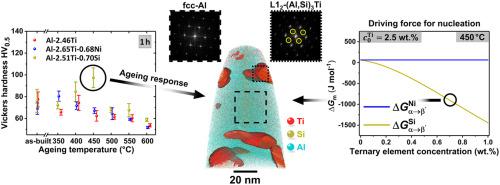Additive Manufacturing ( IF 11.0 ) Pub Date : 2021-09-20 , DOI: 10.1016/j.addma.2021.102315 M. Roscher 1 , S. Balachandran 1 , D. Mayweg 1 , E. Jägle 1, 2

|
In the development of high-strength aluminium alloys tailored specifically to additive manufacturing (AM), L12-Al3X-forming elements have been proven to be particularly effective alloying additions, reducing the susceptibility of aluminium alloys to solidification cracking by grain refinement and increasing the strength by forming secondary nanoscale precipitates. In the present work, we employ laser powder bed fusion (L-PBF) to examine the feasibility of using Ti as the main strengthening, L12-forming element for the design of a well-processable, precipitation-strengthened model alloy. Al-1.76Ti and Al-2.51Ti (wt%) alloys with and without ternary additions of Ni and Si are fabricated during processing from powder mixtures. Crack-free microstructures are produced, which display alternating fine- and coarse-grained regions. During heat treatment, one of the investigated alloys, Al-2.51Ti-0.7Si, exhibits an ageing response due to the formation of nanoscale, metastable L12-(Al,Si)3Ti precipitates, reaching a peak hardness of 97 HV. This demonstrates that L-PBF-processed Ti-containing aluminium alloys can exhibit a precipitation hardening response similar to alloys containing Sc or Zr. In the other Al-Ti-based materials tested, no significant hardness increase was found. This discrepancy is ascribed to the effects Si exerts on the precipitation process. First, the addition of Si increases the thermodynamic driving force for homogeneous nucleation of L12-Al3Ti precipitates. Secondly, Si-Ti co-clustering is observed by atom probe tomography, which is expected to enhance the otherwise sluggish diffusion of Ti. The Al-2.51Ti-0.7Si alloy developed in this work can in the future be further strengthened by adding additional alloying elements and by optimising the heat treatment.
中文翻译:

激光粉末床熔合用铝钛基合金的研制
在专为增材制造 (AM) 量身定制的高强度铝合金的开发中,L1 2 -Al 3 X 形成元素已被证明是特别有效的合金添加剂,通过晶粒细化和通过形成二次纳米级沉淀来提高强度。在目前的工作中,我们采用激光粉末床融合 ( L -PBF) 来检验使用 Ti 作为主要强化材料的可行性,L1 2- 用于设计可加工的、沉淀强化的模型合金的成形元素。Al-1.76Ti 和 Al-2.51Ti (wt%) 合金添加和不添加 Ni 和 Si 的三元添加物是在粉末混合物加工过程中制造的。产生无裂纹的微观结构,显示交替的细晶粒和粗晶粒区域。在热处理过程中,所研究的合金之一 Al-2.51Ti-0.7Si 由于形成纳米级亚稳态 L1 2 -(Al,Si) 3 Ti 析出物而表现出时效响应,达到 97 HV 的峰值硬度。这表明L-PBF 处理的含钛铝合金可以表现出类似于含 Sc 或 Zr 合金的沉淀硬化响应。在测试的其他 Al-Ti 基材料中,没有发现显着的硬度增加。这种差异归因于 Si 对沉淀过程的影响。首先,Si 的添加增加了 L1 2 -Al 3 Ti 析出物均匀成核的热力学驱动力。其次,通过原子探针断层扫描观察到 Si-Ti 共簇,这有望增强 Ti 的缓慢扩散。在这项工作中开发的 Al-2.51Ti-0.7Si 合金将来可以通过添加额外的合金元素和优化热处理来进一步强化。


























 京公网安备 11010802027423号
京公网安备 11010802027423号